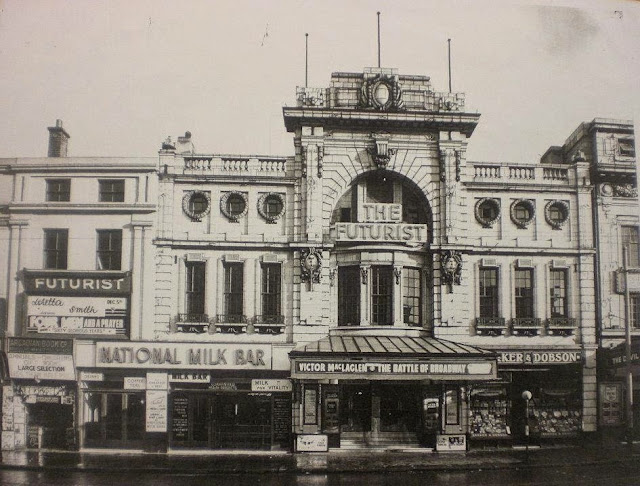There is no better example in Liverpool of the 'Picture Palaces', as they were called, than this one.
Leeds architects C. C. Chadwick & William Watson were commissioned to design the first Liverpool city centre cinema at No.71 Lime Street and the building was erected by W. Wade Sykes in March 1912 and completed approximately seven months later. The site was leasehold from Liverpool Corporation for a peppercorn rent and then came under the management of the Lime Street Picture House Co Ltd which had been formed under the directorship of Edwin Haigh in 1911 with an authorized capital budget of £20.000.
At the Grand Opening on the 16th of September 1912, the Lime Street Picture House was a very upmarket city centre cinema and was described as being 'the finest in the kingdom'. A centrally stepped entrance was flanked either side by shops that were integral to the building. Over the entrance steps, which led to two pairs of glass doors, was a glazed metal framed canopy that had the cinema's name spread across the entire front. The splendid Georgian styled tiled facade was approximately 60 foot in width, with columns, arches, and numerous other ornate features that included the words 'Picture House' carved permanently into the stonework placed up on high.
There were 1,029 seats in the stalls and circle auditorium which was richly decorated with plasterwork in the French Renaissance style. The grand entrance foyer had a black & white square tiled floor and the walls were of Sicilian marble with a decor mainly of Saxe blue. There were several pillars mounted on square pedestals situated near to the turning staircases that led up to a lounge and a luxurious cafe on the 1st floor. The auditorium was designed to have the effect of a live theatre with an abundance of architectural features, embellished by plaster mouldings. The cinema also boasted a full orchestra to accompany the silent films. Two boxes, placed either side of the stage, were purely cosmetic, with a riotous pediment either side of the proscenium looking down into the orchestra pit. The balcony had a sweeping curve that extended to the side walls and the front exits, terminating at the ornate splay walls that focused the eye towards the screen The auditorium walls on both levels were panelled dado in a dark oak wood and punctuated by full length fluted pilasters. The upper level panels above the dado were of light colour and embellished with gold borders. An unusual feature for such an early cinema was the provision of a lift for the circle patrons. Admission prices were 6d. & 1/-, and children were admitted at half price up to 5 p.m. It was re-named City Picture House from the 14th of August 1916.
In October 1920 a new company was formed, Futurist (Liverpool) Ltd, to purchase the cinema and the two shops either side for £167,000. From this time the newly named Futurist and adjacent Scala cinema were both controlled by Levy Cinema Circuit who also had similar named cinemas in Birmingham. Under their management structure business remained brisk until new competition came along from the nearby ABC Forum during 1931 and the massive Paramount cinema on London Road in 1934. The competition began to starve the first-run release to the Futurist resulting in them showing off the circuit releases or prime features after the new cinemas had finished with them.
In May of 1941 both the Futurist and Scala suffered bomb damage. The
Futurist was first to re-open on the 16th of June 1941 with 'The Ghost
Train' which starred Liverpudlian Arthur Askey.
The Levy circuit
then leased the building to 20th Century Fox in May of 1954. The film
company was in dispute with Rank and by acquiring the site they had a
platform for their new films in this major city, thus returning
first-run films onto the Futurist's screen. After the final film,
'Outlaw', starring Jane Russell was shown on the 15th of May 1954, extensive
alterations took place to install a huge Miracle Mirror CinemaScope
screen, behind which, and along the walls of the auditorium, were
mounted numerous speakers to facilitate stereophonic sound. To improve
sight-lines the circle seats were raised on the stepping by 7″. In just
five days the Futurist was open again for continuous business on the
20th of May 1954 with the movie, 'King Of The Khyber Rifles', starring
Tyrone Power. This was the start of a six year run when Fox were able to
present their films, many in CinemaScope, at this well attended venue.
A
more dramatic change happened in 1960 when Fox relinquished their lease
and Alfred Levy decided to sell. ABC became the new owners after
paying £135.000 to purchase the cinema operation and then invested a
further £50.000 on modernisation and re-equipping with 70mm/Todd-AO,
re-opening on the 10th of July 1960 with Gordon Macrea in 'Oklahoma'
which ran for 20 weeks. It became ABC's roadhouse cinema for extended
runs of features such as 'Earthquake'. Eventually, as ABC tripled their
main cinema (the ex-Forum across the street), the Futurist
Cinema was closed on the 17th of July 1982 with a double bill programme
of Mel Brooks', 'History of the World-Part 1' and 'Blazing Saddles' as
only 100 customers watched on the final evening and the 70 year history
of the cinema ended.
Sadly the building lay derelict for many
years and plans were put forward to demolish the Futurist in 2014.
Despite campaigns launched to save it, by 2016 the entire site was
deemed to be structurally unsafe and in May of the same year the cinema
was cordoned off from Lime Street and in the early hours of the 3rd of
August 2016 the demolition commenced.
see also :- http://www.thefootballvoice.com/2022/01/remembering-liverpool-structures_24.html




No comments:
Post a Comment